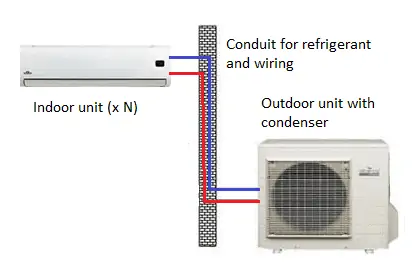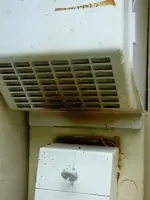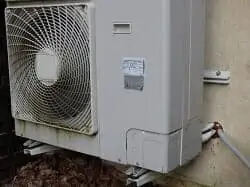No products in the cart.

WHAT ARE THEY?
Heat pumps are high in the public eye in Oceania as an energy-saving heating and cooling system.
They comprise a compressor unit mounted on an external wall which draws outside air through a heat exchanger to warm or chill a refrigerant.
This refrigerant is then piped to each of the distribution units within the house where further heat exchange occurs with the house’s internal air to either cool the air in summer or warm the air in winter.
Heat pump advantages:
The advantages of heat pumps are:
- “kilowatts out” in terms of heating effect are between 3 – 4 times “kilowatts in”. These figures are correct, academically;
- Provides heating in winter and cooling in summer;
- Can heat your hot water.


- Studies in Europe and Canada suggest in practice the energy efficiency ratio of heat pumps as an annual average is only at best 1 kilowatt in to 1.4 kilowatts out. This is because the ratio is based on temperate climate use (when demand for heating and cooling is moderate and so are outdoor temperatures) and not based on high winter or high summer temperatures when the pump has to work much harder to produce heat or cold. Studies in Canada further demonstrate times of the year when the ratio is actually negative (heat pump continues to operate when there is no actual demand for heat).
As a retrofit system into a house with an existing heating system, purchase and installation costs of heat pumps can be very high due to the need to site the external unit as unobtrusively as possible; route coolant pipework and electrical cable into the house and up to the various distribution points. Installation costs can easily eliminate any saving available from the lower running costs of the heat pump for a long period of time. If you’re considering that sort of money, it is better spent on insulation and a less powerful heating / cooling solution.
As a result, payback periods versus other solutions are long (10yrs+), regardless how cheap the energy consumed is, making these a more expensive lifetime cost and poorer investment proposition than Herschel Infrared which will typically pay back within 3-5 years; Heat pumps require annual maintenance and cleaning of air filters. Moving parts wear-out over time. Certain system failures will stop the whole house being heated or cooled.
Heat pumps are also noisy, especially when on their defrost cycle.
They require periodic servicing and replacement parts are very expensive.
They represent a single point of failure for your heating and hot water (you don’t want this happening in mid winter) when things go wrong.
Heat pumps contain considerable embedded carbon in the form of coolant and contain a large proportion of un-recyclable materials.
Other disadvantages with heating air
- Heating air is only effective with the units switched on (and consuming energy). If the distribution units are turned off, then you quickly revert to a cold house.
- Warm air over cold surfaces is a cause of mould.
- Heat pumps do not work effectively if the property is poorly insulated. Older Australian and NZ homes are subject to high thermal and air infiltration losses (drafts) which work against the efficiency of heat pumps.
- It is uncomfortable being in the direct path of the heated air.
- Warm air when convected over cool building fabric is a key contributor to damp and mould.
Herschel Infrared Heating as an alternative to heat pumps:
- If a house has an existing immersion heater as well as the boiler, (many do), then leave this in place or consider the cost of upgrading to a modern more energy-efficient Immersion making use of overnight economy rates.
- The purchase price of Herschel Infrared heating panels throughout the house is competitive relative to the cost of purchasing Heat pump components (compressor, immersion, cluster).
- The installation costs of Herschel infrared will be significantly less than the cost of installing a heat pump and can be carried out by a general electrician over only a couple of days with minimal disruption to the house. A heat pump installation requires specification by a qualified heat pump specialist; a builder will be required to handle aspects of the structural changes to the house and refrigerants must be handled by a qualified refrigerant engineer.
- In a well insulated new-build house, the energy consumption of Herschel Infrared heating or a heat pump will be at their most efficient – but because of the lower capital costs, the payback on the Infrared system will be quicker.
- In older properties, heat pump installation costs will be high and without enlarging the existing radiators and proper insulation, the energy-efficiency benefits far harder to achieve, with payback terms of 10 years+. On the other hand, the installation costs of Herschel infrared will be minimal and the Herschel Infrared will heat walls, floors and ceilings evenly keeping operating costs optimal, making the overall payback term far more attractive.
- Herschel Infrared provides excellent comfort levels – including warming the floor – without needing specialist underfloor heating.
- No ongoing maintenance is required for Herschel Infrared heating panels. Maintenance requirements for immersion systems are rare and no worse than the existing system being replaced.
Herschel Infrared advantages:
- Purchase and installation price of infrared are much less than the cost to purchase and install Heat pumps;
- Can be run from domestic solar and wind installations therefore being “free” (impossible for heat pumps);
- The heat transfer efficiency of Infrared is superior to hot air, with no infiltration losses, meaning less wattage is required for less time – dramatically reducing the energy efficiency argument of heat pumps in real world use;
- Heats and dries the building fabric, removes damp and mould;
- No maintenance requirements over the product’s lifetime;
- Total cost of owning Infrared over the product’s lifetime is lower than for heat pumps and lower capital outlay also means payback times are quicker.
Other Advantages
- Discreet design. Panel disappears as a heat source once the building’s thermal mass is established;
- Silent operation;
- No air movement means a more comfortable environment for all;
- Cost efficiently warms your home ‘around the clock’.
Herschel Infrared disadvantages:
- Heating only, not for cooling, so a cooling solution also needs to be obtained (in hotter climates where this is relevant).
- Does not heat your hot water, although houses for which the heat pump is a retrofit already have a hot water solution (e.g. immersion heater).
